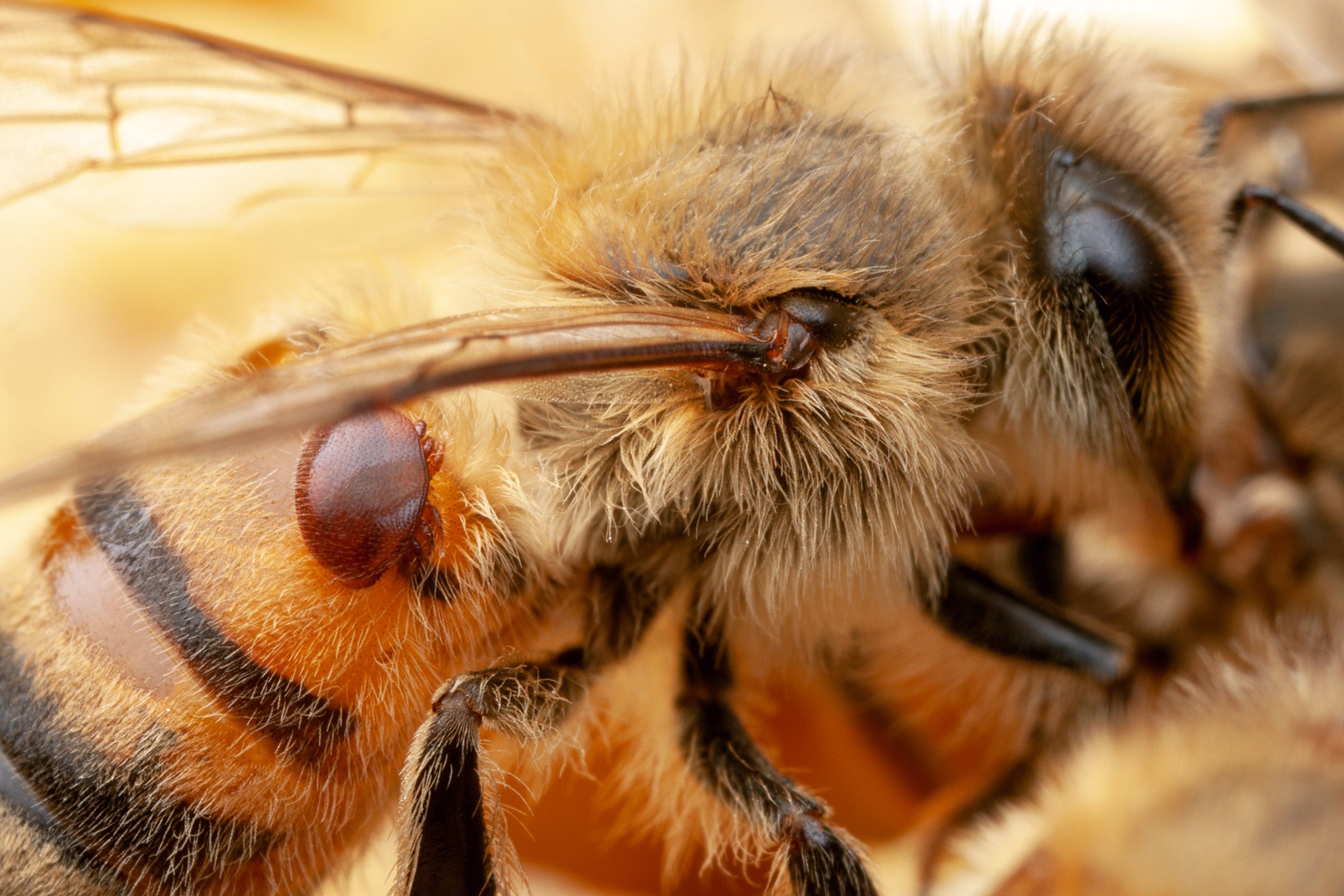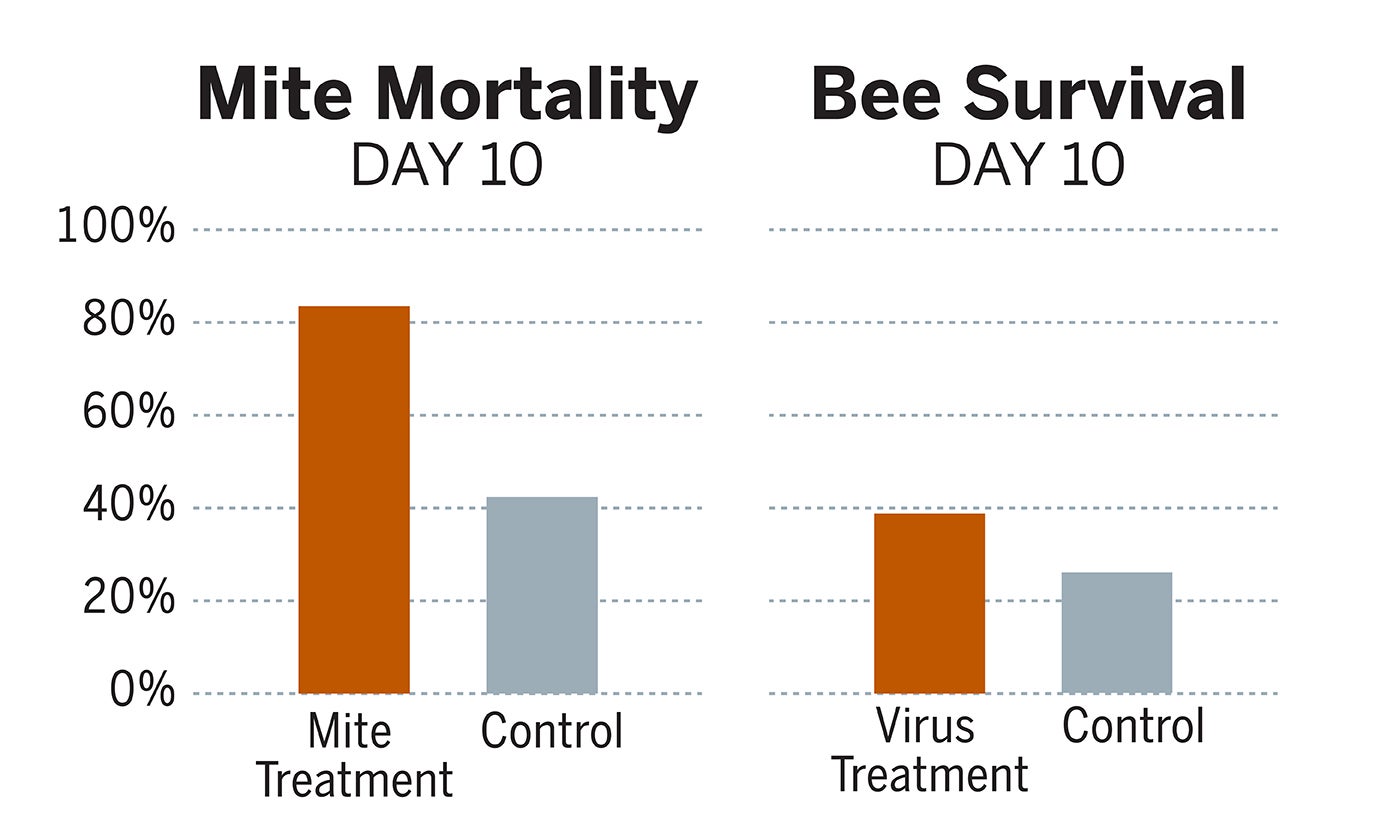Bacteria Engineered to Protect Bees from Pests and Pathogens
Genetically engineered strains of bacteria protect bees from mites and viruses that can lead to colony collapse.

A Varroa mite, a common pest that can weaken bees and make them more susceptible to pathogens, feeds on a honey bee. Photo credit: Alex Wild/University of Texas at Austin.
Scientists from The University of Texas at Austin report in the journal Science that they have developed a new strategy to protect honey bees from a deadly trend known as colony collapse: genetically engineered strains of bacteria.
An increasing number of honey bee colonies in the U.S. have seen the dwindling of their adult bees. According to a national survey, beekeepers lost nearly 40% of their honey bee colonies last winter, the highest rate reported since the survey began 13 years ago.
The engineered bacteria live in the guts of honey bees and act as biological factories, pumping out medicines protecting the bees against two major causes of colony collapse: Varroa mites and deformed wing virus. The researchers believe their method could one day scale up for agricultural use because the engineered bacteria are easy to grow, inoculating the bees is straightforward and the engineered bacteria are unlikely to spread beyond bees.
"It has direct implications for bee health," said Nancy Moran, a professor of integrative biology and the primary investigator on the study.
"This is the first time anyone has improved the health of bees by genetically engineering their microbiome," added Sean Leonard, a graduate student and first author of the study.
Varroa mites and deformed wing virus often come together; as the mites feed on bees, they can spread the virus, while also weakening the bees and making them more vulnerable to pathogens in the environment.
To address each problem, the team engineered one strain of bacteria to target the virus and another for the mites. Compared with control bees, the bees treated with the strain of bacteria targeting the virus were 36.5% more likely to survive to day 10. Meanwhile, Varroa mites feeding on another set of bees treated with the mite-targeting strain of bacteria were about 70% more likely to die by day 10 than mites feeding on control bees.
According to the American Beekeeping Federation, honey bees contribute nearly $20 billion each year to the value of U.S. crop production, and they play an enormous role in global food production. Without honey bees, dozens of crops, from almonds to berries to broccoli, would either vanish or produce significantly less food.
Like humans, honey bees have an ecosystem of bacteria in their guts called a microbiome and also an antiviral defense mechanism called RNA interference (RNAi) that helps the body fight off certain viruses, called RNA viruses. When an RNA virus is introduced, it produces molecules called double-stranded RNAs that a healthy cell detects, triggering an RNAi immune response.
"You usually only get signs of these molecules when an RNA virus is replicating," Moran said. "It's a signal that this might be an evil thing and you should attack it."
To promote a helpful RNAi response to viruses in bees — and trigger a lethal RNAi response in the mites — the team introduced modified bacteria to hundreds of bees in a laboratory setting. Sprayed with a sugar water solution containing the bacteria, the bees groomed one another and ingested the solution. The team found inoculating young worker bees with the engineered bacteria led the bees' immune systems to be primed to protect them against deformed wing virus, which is an RNA virus, and caused the mites' own immune systems to fight against and ultimately kill them.
While the experiments occurred under strict biocontainment protocols used with genetic engineering, Moran said, even absent such protocols, the risk of the engineered bacteria escaping into the wild and infecting other insects — and thereby conferring some anti-pest or anti-pathogen superpowers — is very low. The type of bacteria used are highly specialized to live in the bee gut, can't survive for long outside of it and are protective for a virus that strikes only bees. Still, further research will be needed to determine the effectiveness and safety of the treatments in agricultural settings.
Another benefit of the approach is for researchers to use it as a tool in studying bee genetics. The engineered bacteria can knock down specific bee genes, enabling insights into the workings of the bee genome, and possibly enabling new breeding strategies to produce more robust bee colonies.
The other senior author is associate professor Jeffrey Barrick. Other co-authors are professor Andy Ellington, associate professor Bryan Davies, research associate Eli Powell, former postdoctoral researcher Jiri Perutka, postdoctoral fellow Peng Geng, undergraduate Luke Heckmann and research scientist assistant Richard D. Horak.
Moran, whose remarkable career was recently profiled in Science magazine, holds the Warren J. and Viola Mae Raymer Chair. Funding for this research was provided by the National Institutes of Health and the Defense Advanced Research Projects Agency.
Download high resolution images associated with this release

Compared with control bees, the bees treated with the strain of bacteria targeting the deformed wing virus were 36.5% more likely to survive to day 10. Meanwhile, Varroa mites feeding on another set of bees treated with the mite-targeting strain of bacteria were about 70% more likely to die by day 10 than mites feeding on control bees. Credit: University of Texas at Austin.
More Info
RNA viruses infect bees and humans, and when they do, the viruses produce molecules called double-stranded RNAs (dsRNAs). If a healthy cell detects these molecules, their presence triggers an RNAi immune response. For one part of the experiment, the researchers genetically engineered a strain of Snodgrassella alvi bacteria, which are typical members of healthy honey bee microbiomes, to produce dsRNAs containing bits of genetic code from the deformed wing virus.
In another part of the experiment, they genetically engineered another strain of Snodgrassella alvi to produce dsRNAs containing bits of genetic code from essential genes in Varroa mites.
"When the mites feed on the bees' blood, they ingest that double-stranded RNA themselves, and it triggers a lethal RNAi response in the mites," Leonard said. "The mites mount an immune response against their own genes that kills them."
The original research was done in a laboratory setting under strict biocontainment protocols to ensure that genetically engineered bacteria were not released into the wild. To test the concept in a larger experiment, where there are many hives, each with thousands of bees foraging long-distance in a complex environment, researchers would need to provide biocontainment over a large, semi-natural area to mimic a real-world scenario. Nonetheless, the researchers believe their method could scale up to large-scale agriculture without much difficulty.
Other researchers have engineered microbes to attack and kill insects — for example, researchers reported in the journal Science last May that they had engineered a fungus to deliver toxins to the kinds of mosquitoes that carry malaria. But this is the first case of researchers genetically altering the microbiome of an insect to protect it.



